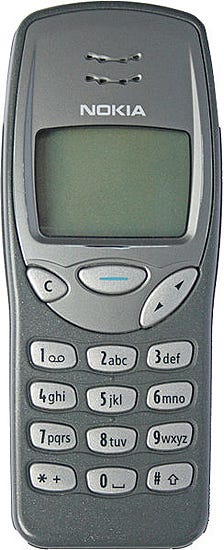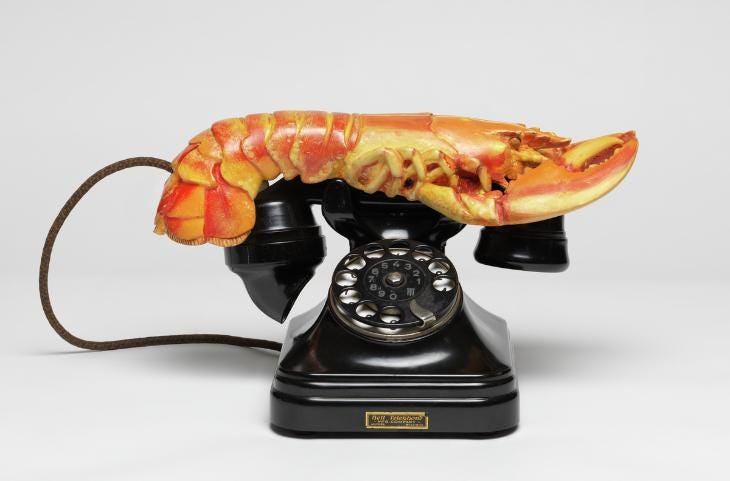#125 Design calling 📞
Predictive text, lobster telephones and more
Happy new year! 2023 is calling and we’re on the line with design stories from the history of telecommunication. We’re diving into the origin of the T9 predictive text system and also taking time to admire Salvador Dali’s infamous lobster telephone 🦞
Enjoying Design Lobster? Please share it with a friend, colleague or fellow designer
Question: Who invented T9 predictive text?

T9 (Text on 9 keys) is a predictive text technology for mobile phones that assigns three or four letters of the alphabet to each key. By predicting what you meant to type based on a single tap, rather than forcing you to tap through all of them to make a selection, it massively speeds up text entry. You may well remember the first time you sent your first text message in this way. For me, it was at age twelve in 2003 from a Samsung E700 flip phone – God only knows what the content of the message was! 😅
T9 was invented by Cliff Kushler and Martin King of Tegic Communications around 1995. They’d originally been exploring an eye-tracking system for those with motor impairments. That system had used eight “gaze zones” but the pair quickly realised this concept also translated well to the restricted setting of a mobile phone’s numerical keypad.
This deep-dive relates the development of T9 in great detail and contains interesting reflections on the challenge of introducing the feature to users accustomed to multi-tap. T9 is unintuitive at first because it keeps showing you the the wrong word until you’ve tapped a key for every letter, and the T9 team struggled to introduce a consistent onboarding experience across the many devices they needed to support.
Nevertheless, with SMS texting taking off in the late 90s in Europe and America, T9 found itself adopting by the vast majority handset manufacturers, convinced by data that showed users with T9 installed sent more messages. Astonishingly, by 2007, it’s estimated that over 4 billion devices with T9 had shipped 🤯
Design takeaway: How could you predict the intent of the people using your design?
Object: Lobster telephone

The Lobster Telephone, also known as the Surrealist Telephone or Aphrodisiac Telephone, was a design created by Surrealist artist Salvador Dalí for his collector and patron Edward James. Made in London in 1938 by interior decorator Green and Abbott, various versions exist – including all-white ones, but they all feature a functioning telephone of some kind upon whose receiver a plaster-cast of a lobster sits. At that time all telephone sets were technically owned by the Government and there were penalties for damage, so the lobster cast is only lightly screwed in and can easily be removed.
The design has been interpreted in various ways. As in other Surrealist works, the collision of something as everyday as a telephone with a sea creature gives the telephone a dream-like quality that is intended to help us see the world with fresh eyes. Some critics have also picked up on the sexual connotations that Dalí ascribed to lobsters and the risqué placement of its tail at the end of the telephone where the speaker must place their mouth.
I always wonder quite how seriously to take Surrealist design, and can’t help but feel that the Dalí would have giggled at the reverence with which they are treated in museum collections. I do though always appreciate anything that helps us see the world in a new way, and I feel like Dalí’s mischievous spirit lives on among the objects of the Ugly Design instagram.
Design takeaway: What could you unexpectedly collide into your design?
🦞 More lobster-themed design from this time last year…
Quote: “Most people never pick up the phone and call. Most people never ask, and that’s what separates the people who do things from the people who just dream about them.”
– Steve Jobs
This is a time of year when lots of us might be contemplating what we want to achieve over the next 12 months. This quote comes from an interview where Steve Jobs narrates a cold call to Bill Hewlett he made as a precocious twelve-year-old that got him a summer job on the Hewlett Packard assembly line.
Whatever you’re planning in 2023, I hope you can find the courage to make that first call.
Ben 🦞
Enjoyed this week’s Design Lobster? Let me know by clicking the heart button ❤️
👇


I was very much involved in the mobile space at that time in New Zealand, including as President of the NZ Wireless Forum. TXT messaging in the early days, as soon as people got why they might want to use it produced more ARPU than anything else. It started at 50c a message, then went down to 20c per message.